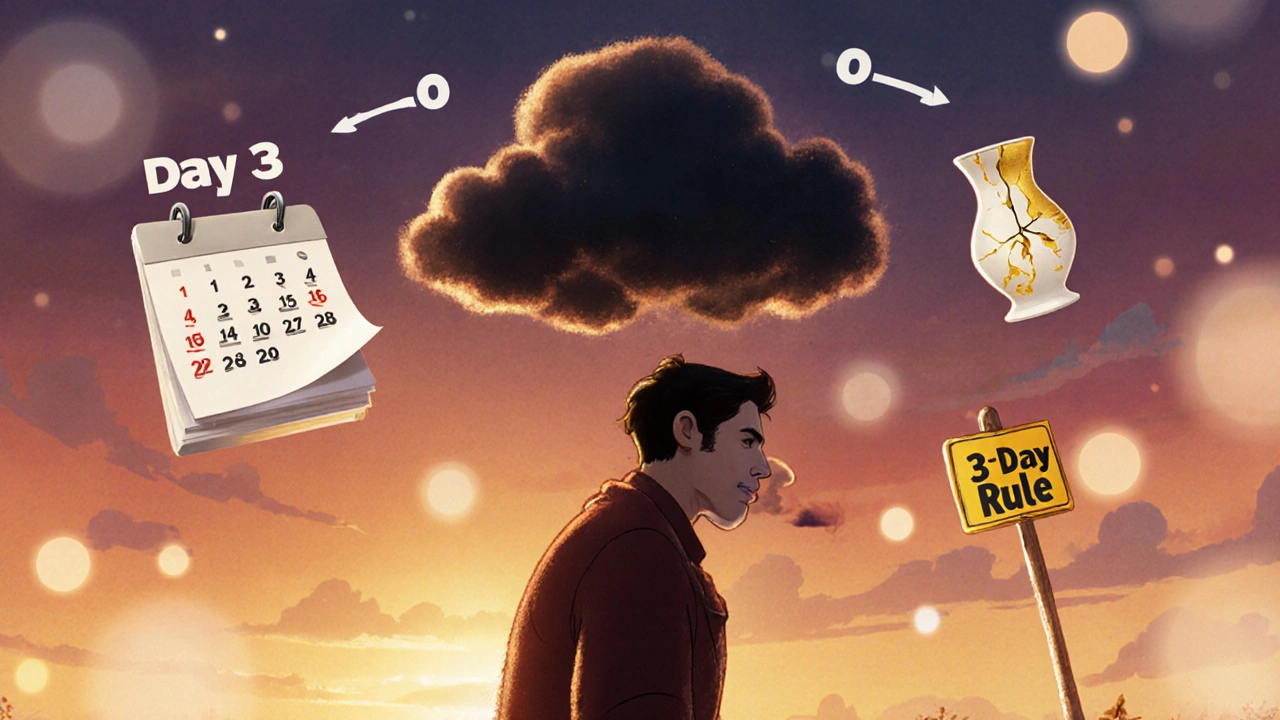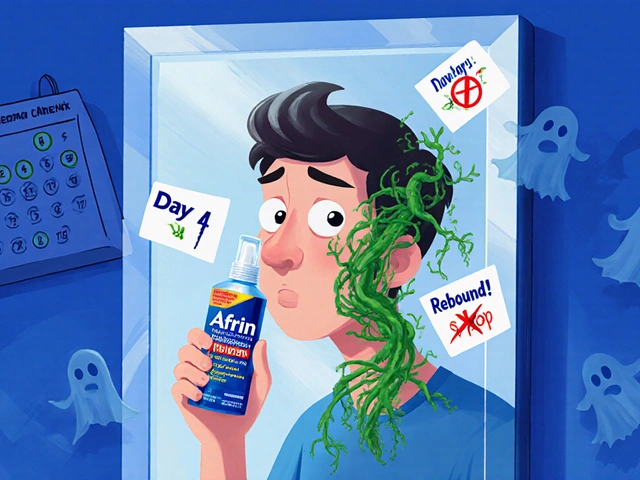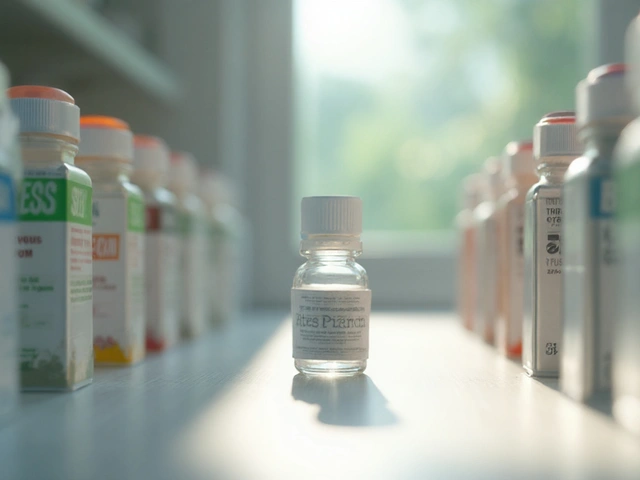
Most people reach for an OTC nasal spray when their nose is clogged - maybe from a cold, allergies, or sinus pressure. It feels like magic: one spray, and suddenly you can breathe again. But here’s the catch - if you keep using it past three days, that relief turns into a trap. Your nose gets worse. Not because your cold is back, but because the spray itself is causing the problem. This isn’t rare. It’s called rebound congestion, and it’s the most common reason people end up stuck in a cycle they didn’t know they were in.
What Is Rebound Congestion?
Rebound congestion, also known as rhinitis medicamentosa, happens when nasal decongestant sprays - the kind you buy without a prescription - stop working the way they should. Instead of clearing your nose, they start making it more blocked. It’s not your allergies getting worse. It’s not a new infection. It’s your nasal blood vessels reacting to the medicine.
These sprays contain chemicals like oxymetazoline (found in Afrin) or phenylephrine (in Neo-Synephrine). They work by shrinking swollen blood vessels in your nose. That’s why you feel better so fast - within 5 to 10 minutes. But when the effect wears off, usually after 8 to 12 hours, the vessels don’t just return to normal. They overcompensate. They swell even more than before. That’s the rebound. And if you keep spraying, your nose gets used to it. Soon, you need more sprays, more often. What started as a quick fix becomes a daily dependency.
Doctors have seen this for decades. The first cases were documented in the 1900s, but it’s still happening today. About 1 to 2% of the general population develops this condition, according to the Cleveland Clinic. And among people who use these sprays regularly, up to 10% will eventually get stuck in the cycle. It’s not a myth. It’s a well-documented medical problem.
Why Three Days Is the Hard Limit
You’ve seen the warning on the bottle: “Do not use for more than 3 days.” But most people ignore it. Why? Because it works. So why stop?
The truth is, the damage can start as early as day three. Research from Houston Methodist and the NIH shows that after 72 hours of continuous use, your nasal tissues begin to change. Blood vessels become more sensitive. The lining gets inflamed. You’re not just treating congestion - you’re creating it.
Here’s what happens when you go past the limit:
- Day 1-3: Congestion improves quickly. You feel relief.
- Day 4: You notice your nose feels stuffy again sooner than before. You spray again.
- Day 5-7: You’re spraying 4-6 times a day. The relief lasts less than 4 hours.
- Day 8+: You’re spraying every few hours. Your nose feels blocked even when you haven’t sprayed. You think you’re getting sicker.
That’s not a worsening cold. That’s rebound congestion. And it doesn’t go away just because you stop the cold. The spray is the cause now.
What Happens When You Quit
Stopping the spray cold turkey is the hardest part. Your nose will feel worse - much worse - for a few days. That’s normal. But it’s temporary.
Most people experience peak congestion 48 to 72 hours after their last spray. Symptoms can last anywhere from 1 to 3 weeks. In some cases, especially with long-term use, it can drag on for 4 to 6 weeks.
But here’s the good news: your nose can heal. It just needs time and the right support.
People who try to quit cold turkey often describe it as “Afrin hell.” Reddit threads and patient forums are full of stories like: “I thought my allergies were getting worse - turns out it was the spray.” Or: “It took me three weeks of misery to break the cycle.”
And it’s not just discomfort. Long-term misuse can lead to more serious issues - chronic sinus infections, damage to the nasal septum, or even tiny holes in the cartilage. These are rare, but they happen. And they’re preventable.

What to Use Instead
You don’t have to suffer through rebound congestion. There are better, safer options.
Salt Water Sprays (Saline)
These are your best friend during withdrawal. Saline sprays - like NeilMed Sinus Rinse or store-brand sodium chloride solutions - don’t contain any drugs. They just flush out mucus, reduce swelling, and keep your nasal passages moist. Use them 4 to 6 times a day during recovery. No risk. No rebound. No side effects.
Flonase and Other Steroid Sprays
Flonase (fluticasone), Nasacort (triamcinolone), and other OTC nasal steroids are the next step. These aren’t quick fixes. They take 3 to 7 days to start working. But once they do, they reduce inflammation at the source - not just the blood vessels. That’s why they’re perfect for allergies and chronic congestion.
Unlike decongestants, steroid sprays don’t cause rebound. They’re safe for daily, long-term use. Many ENT specialists now recommend starting a steroid spray on day two of decongestant use - not as a replacement, but as a backup plan. That way, if you need to stop the decongestant, your nose already has support.
Oral Decongestants (Use With Caution)
Pseudoephedrine (Sudafed) is an option. It works systemically, not just in your nose. But it’s not for everyone. It can raise your blood pressure, make your heart race, or cause trouble sleeping. If you have high blood pressure, heart disease, or take antidepressants, avoid it. Talk to your pharmacist first.
How to Break the Cycle Safely
If you’ve been using a nasal decongestant for more than 3 days, here’s how to stop without suffering:
- Start using saline spray 2-3 times a day. Keep your nose moist.
- Begin using a nasal steroid spray (like Flonase) once daily. Don’t expect instant results - give it 3-5 days.
- On day 1 of quitting, cut your decongestant spray in half. If you were using it 3 times a day, now use it only 1-2 times.
- Every 48 hours, reduce the number of sprays by one. So if you’re on 2 sprays, go to 1. Then wait 2 days. Then stop.
- During this taper, keep using saline and steroid sprays. They’ll help manage the withdrawal.
- Expect worse congestion for 2-4 days. That’s normal. Don’t go back to the decongestant.
This method reduces the shock to your system. It’s slower, but it works. Most people find relief within 7-14 days. Abruptly stopping can take 4-6 weeks.

Who’s at Higher Risk?
Not everyone who uses these sprays gets rebound congestion. But some people are more vulnerable:
- People with high blood pressure - the chemicals in these sprays can raise BP even more.
- Those with chronic nasal issues - like deviated septum or chronic sinusitis - are more likely to rely on sprays long-term.
- People who use them for allergies - steroid sprays are the right tool here, not decongestants.
- Anyone using them for more than 5 days straight - the risk jumps sharply after day 3.
If you’ve used a decongestant spray for more than a week, even once, you’re already at risk. Don’t wait until it’s a problem. Be proactive.
What the Labels Don’t Tell You
The FDA has required the “Do not use for more than 3 days” warning since 2002. But studies show 38% of users ignore it. Why? Because the relief is so strong. And because most people don’t know what rebound is.
Manufacturers don’t advertise the risk. Ads show happy people breathing easily - not the weeks of misery that follow. You’re not dumb for getting stuck. You’re just human.
The real problem isn’t the spray. It’s the lack of clear, simple education. If you know the rules, you can use these sprays safely. If you don’t, you’re playing Russian roulette with your nose.
Bottom Line: Use Wisely, Not Often
OTC nasal decongestant sprays are powerful tools - but only for emergencies. Think of them like a fire extinguisher. You don’t keep spraying it just because the room feels warm. You use it when there’s a real fire - and then you get out.
Use them for:
- A bad cold with severe congestion
- Traveling with sinus pressure
- Prepping for a flight or surgery
Don’t use them for:
- Chronic allergies
- Daily nasal stuffiness
- Long-term sinus problems
If your nose is blocked more than a few days in a row, see a doctor. You might need allergy testing, a sinus evaluation, or a better treatment plan. Don’t keep reaching for the spray. Your nose will thank you.
Can I use OTC nasal spray every day?
No. OTC nasal decongestant sprays like Afrin or Neo-Synephrine should never be used every day. Using them for more than 3 consecutive days can cause rebound congestion, where your nose becomes more blocked than before. These sprays are meant for short-term relief only - no longer than 3 days. For daily congestion, use saline sprays or steroid sprays like Flonase, which are safe for long-term use.
How long does rebound congestion last after stopping the spray?
Rebound congestion typically lasts 1 to 3 weeks after stopping the spray, but it can take up to 6 weeks if you used it for months. The worst symptoms usually peak 2 to 3 days after your last dose. Using saline rinses and steroid nasal sprays like Flonase can shorten recovery time. Abruptly stopping without support often leads to longer discomfort.
Is Flonase better than Afrin for nasal congestion?
Yes - for long-term use, Flonase is far better. Afrin gives fast relief but causes rebound congestion if used beyond 3 days. Flonase (a steroid spray) takes 3-7 days to work but reduces inflammation safely without dependency. It’s ideal for allergies, chronic congestion, and recovery from rebound. Use Afrin only for emergencies; use Flonase for ongoing issues.
What happens if I use nasal spray for a month?
Using a nasal decongestant spray for a month can cause severe rebound congestion, chronic nasal swelling, and even permanent damage to the nasal lining. Many people develop a dependency, needing to spray 6-10 times a day just to breathe. Some develop chronic sinusitis or, in rare cases, a perforated nasal septum. Stopping requires medical guidance and can take weeks to recover. Never use these sprays for more than 3 days without consulting a doctor.
Can kids use OTC nasal sprays?
Most OTC nasal decongestant sprays are not approved for children under 6 years old. For older kids, they should only be used for 1-2 days under adult supervision. Rebound congestion can happen in children too, and their nasal passages are more sensitive. Saline sprays are the safest option for kids. Always check the label or ask a pharmacist before giving any nasal spray to a child.
If you’ve been relying on nasal spray for more than a few days, you’re not alone. But you can break free. Start with saline. Add a steroid spray. Taper slowly. And give your nose time to heal. It’s not magic - but it works.






Used Afrin for a week once. Worst 3 weeks of my life.
I had no idea this was a thing. I thought my allergies were just getting worse every winter. Turns out I was just addicted to the spray. I started using saline rinses last month and my nose hasn’t felt this clear in years. Still weird to think a little bottle could trap you like that.
The FDA warning has been on these bottles since 2002, yet 38% of users ignore it. That’s not ignorance-it’s negligence. Manufacturers don’t need to advertise the risk because the relief is so potent, and people are biologically wired to chase short-term rewards. This isn’t a medical issue; it’s a behavioral one. Stop blaming the product and start taking responsibility for your own usage patterns.
I went through Afrin hell for 11 weeks. I cried in the shower because I couldn’t breathe. My partner had to hold my hand while I begged for one more spray. I thought I was dying. No one warned me. No doctor asked. I just kept buying it because ‘it works.’ Now I’m terrified of every sniffle.
This is one of the most important public health messages you’ll read this year. Nasal decongestant sprays are not candy-they’re pharmacological tools with serious risks. The fact that they’re sold over-the-counter without mandatory counseling is a systemic failure. Every pharmacy should have a small card next to them: ‘3 days max. If you need more, see a doctor.’ Simple. Clear. Life-changing. Thank you for this post.
my nose feels like a desert now after quitting… but i swear i can feel it healing? like little tiny sparks of air moving through. it’s been 12 days and i still wake up gasping but… i’m not reaching for the spray. i’m drinking water. i’m using the saline. i’m breathing slow. it’s not magic, but it’s mine again. thank you for saying this out loud.
As someone from India where nasal sprays are often used as a cure-all for headaches and colds, I can tell you this problem is rampant here too. People use them daily for months without knowing the consequences. I’ve seen patients with perforated septums from long-term misuse. The education gap is massive. We need community health workers to spread this message-especially in rural areas where doctors are scarce. This isn’t just an American issue.
I used to think people who said they were addicted to nasal spray were exaggerating. Then I became one. It took me 6 weeks to get through withdrawal. I tried everything-steam, humidifiers, even sleeping with my head hanging off the bed. Nothing worked until I started Flonase. I didn’t believe it at first, but after 5 days, I could breathe through my nose for the first time in months. I’m not ashamed to say I cried. It was worth it.
why does no one talk about how embarrassing this is? you’re sitting there at work, spraying your nose every hour like a robot. people notice. you start avoiding eye contact. you lie and say you have allergies. it’s not just physical-it’s social. i’m glad this post says it out loud.
Actually, the 3-day limit is outdated. Studies from 2021 show that some individuals can tolerate up to 5 days without rebound if used intermittently-like 2 sprays per nostril, once every 12 hours. The real issue is frequency and duration. It’s not just days-it’s dosage. You’re oversimplifying the science.
Rebound congestion? It’s not ‘rebound’-it’s a physiological rebellion. Your nasal vasculature, once manipulated by synthetic vasoconstrictors, develops a form of tolerance akin to opioid dependence. The body doesn’t ‘overcompensate’-it rewrites its own regulatory logic. You’re not just addicted to a spray-you’ve altered your autonomic nervous system’s baseline. And now, you must relearn how to breathe. This isn’t medicine. It’s neurobiological sabotage.
There’s a quiet poetry in healing your nose after addiction. It’s not glamorous. No one takes pictures of it. But there’s something sacred about breathing freely again-not because a chemical tricked you into feeling better, but because your body remembered how to do it on its own. It’s a reminder: sometimes the most powerful medicine isn’t in a bottle. It’s in patience, in stillness, in letting go.
So you’re telling me the solution to a problem created by pharmaceutical companies is… more pharmaceutical companies? Flonase is just another drug with a different label. The real answer? Stop buying into the idea that every sniffle needs a chemical fix. Let your body do its job. Maybe your nose isn’t broken-maybe you’re just overmedicating.
Let’s be real-this is just another case of capitalism turning a minor symptom into a lifelong dependency. Companies make billions selling quick fixes while burying the long-term risks in tiny print. And now we’re supposed to be grateful for a post that says ‘don’t use it too much’? Wake up. The system is rigged. The spray is the symptom, not the cause.
As a physician who has managed dozens of cases of rhinitis medicamentosa over the past two decades, I can confirm that the clinical presentation is remarkably consistent: patients present with progressive nasal obstruction, increasing frequency of spray use, and a profound sense of helplessness. What’s alarming is not the condition itself, but the fact that primary care providers rarely screen for it. Patients are not asked about OTC nasal spray use during routine visits. There is no algorithm, no checklist, no standardized counseling. This is a systemic failure in preventive medicine. I urge clinicians to routinely ask: ‘Are you using any nasal sprays regularly?’ and to educate patients proactively-not reactively. The damage is preventable. The recovery is possible. But only if we stop treating this as a patient’s fault and recognize it as a failure of our healthcare communication.